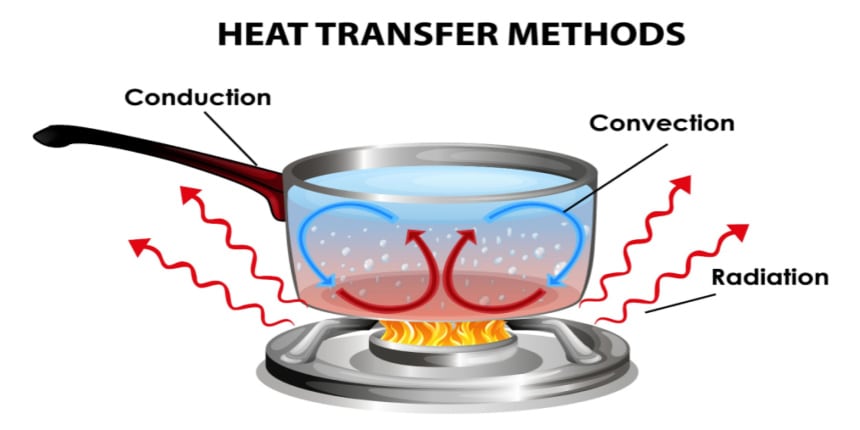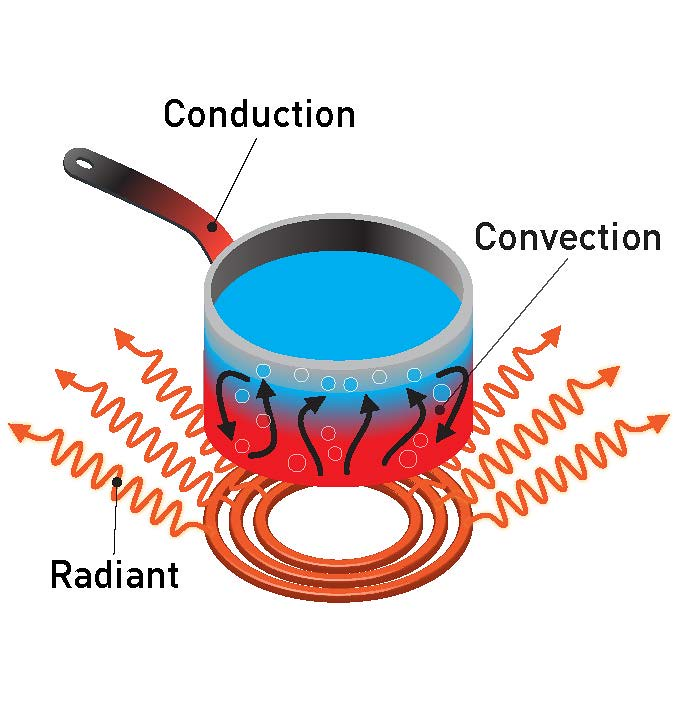Difference Between Conduction Convection and Radiation
What is the difference between conduction, convection, and radiation - The matter is differentiated into three states known as solid, liquid, and gas. One matter can be converted into another matter. During this state change, heat transfer occurs between the system and the surroundings. Heat transfer is a physical act or the process of thermal energy between two different systems or two different objects of the same system by the method of heat dissipation.
This Story also Contains
- Difference Between Conduction Convection and Radiation:
- Methods Of Heat Transfer
- Conduction
- Convection
- Radiation

Let us discuss heat transfer types namely radiation, convection, and conduction. we also discuss the difference between conduction and convection, (convection vs conduction), and the difference between conduction, convection, and radiation. here below students can find a comparison of conduction, convection, and radiation.
Difference Between Conduction Convection and Radiation:
| Conduction | Convection | Radiation |
| In the process of conduction, heat gets transferred between substances with direct contact with solids | In the process of conduction, heat gets transferred between substances like fluid | In the process of radiation, heat gets transferred through the means of electromagnetic waves without any interaction between particles. |
| The process is carried out by the electrons | The process occurs mainly due to the movement of the molecules | The process is carried out in the form of the Em waves |
| The transfer of heat occurs due to temperature difference | The transfer of heat occurs due to the density difference between the fluids | The transfer of heat takes place in objects which have temperatures higher than 0K |
| In conduction, the transfer of heat is a slow process | In convection, the transfer of heat is faster than in conduction | In radiation, the transfer of heat is the fastest process compared with conduction and convection |
| The transfer of heat through some solid heated object | The transfer of heat through some intermediate objects. | The transfer of heat happens through the Em waves |
| The conduction process will not obey the laws of reflection and the laws of refraction. | The convection process will not obey the laws of reflection and the laws of refraction. | The conduction process will obey the laws of reflection and the laws of refraction. |
| The conduction process continues until both substances are maintained under an equal temperature | The convection process occurs only when the temperature difference occurs between the objects. | Radiation processes at any condition as the energy can be transferred through space. |
| This process occurs only in solid matter. | This process occurs in the fluid. (includes both solids and liquids)) | This process takes place in all matters like solids, liquids, and gases which have a temperature above 0k. |
Interested students can also check the following links. here they can find NCERT solutions for all class.
- NCERT Solutions for Class 11 Physics
- NCERT Solutions for Class 12 Physics
- NCERT Solutions for All Subjects
Methods Of Heat Transfer
Do you know how heat transfers from one object to another object? There are mainly three different modes of heat transfer which are listed below.
- Conduction
- Convection
- Radiation
Conduction
The heat transfer in any solid body (without any radiation flow) occurs due to collision between the higher energy molecules with lower energy molecules is known as conduction. The collision occurs due to the free electrons in the solids. This process occurs along with the high vibration of solids. Heat cannot be transferred from a low-temperature object to a high-temperature object unless it is subjected to external forces. The objects or substance which allows the heat to pass through is known as conductors. Example: Metals are good conductors and heat conduction is easily found in metals. similar to flow electricity, ability of material to transfer heat is know as thermal conductivity.
The elastic bonding between the dielectric solids, the molecular movement occurs like waves. These waves are similar to echo waves. But compared to echo waves, they have very high frequencies and are also quantized like phonons. Phonons relay high energy from hotter sections to cooler sections. The conduction of heat takes the phonons as gas molecules that travel inside a solid which have material irregularities. The heat conduction of nonmetallic liquids is intermediate lies between solids and gases.
Also read :
Convection
The heat transfer that occurs in fluid due to the movement of the molecules in the fluid is known as convection. The process occurs both naturally and artificially. Gravity and buoyancy play an important role in this process. The hot object moves upward and the cold object sinks. for example example Air heating systems. this movement of fluid due to temperature difference knw as convection current. There are two types of convection namely Natural / free convection and Forced convection.
Natural / free convection
When the motion of the fluid occurs due to the presence of a hot object in it. The fluid shift occurs due to the influence of gravity, it is called natural convection. It is also known as free convection.
Forced convection
When the relative motion occurs between a hot object and the fluid, some external agent is required to maintain the convection, it is called forced convection.
Also, there are some important related topics. interested students can read to know more about the topics.
Radiation
Heat transfer is which the heat can be transferred in the form of electromagnetic waves. This process does not require any medium for energy transfer. There is no requirement for any direct contact or molecule movement for this process. It occurs without touching the object. Radiation depends on some kind of surface properties like color, the orientation of the surface, and so on. The energy carried out by the EM waves is known as radiant energy. This energy can travel through a vacuum from the source to its surroundings. Example: The heat from the sun that reaches earth takes the form of EM waves and this is one of the radiation waves.

NCERT Physics Notes :
From this article, We saw the heat transfer in detail, and also saw the difference among conduction, convection, and radiation. Now, let us see some of the frequently asked questions from class 10, class 11, and class 12.
Also, check-